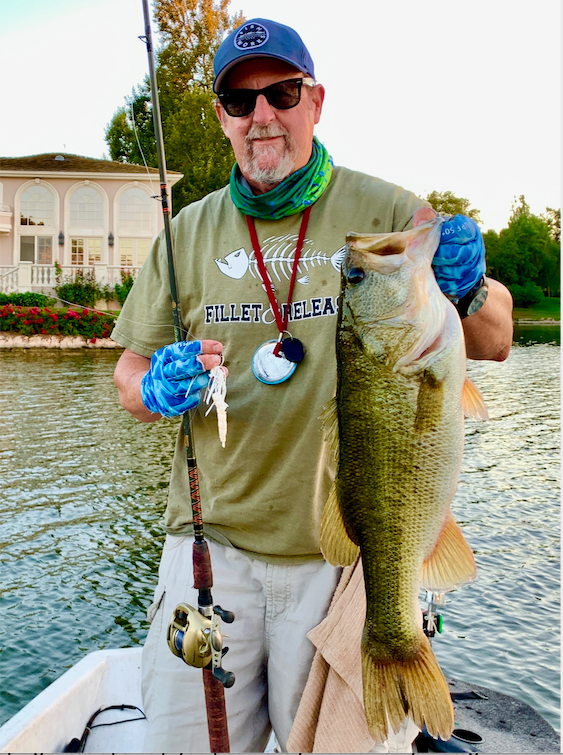
5 Pre-spawn ChatterBait tactics that will put more bass in your boat
BY JON DICKENS
If you’re a freshwater bass angler, your favorite time of the year is about to begin. Pre-spawn. The bass are waking up and will soon be as hungry as a bear coming out of hibernation. They’re getting ready to move into the shallows, put on the feedbag and bulk up before the water temperature tells them it’s time to make babies.
So, what are you going to throw at them? The options can be overwhelming. At this time of year though, search baits are a good choice and one of the best is the bladed swim jig, more commonly referred to by the name Ron Davis, the inventor, gave it – the ChatterBait. Let’s take a deep dive into how to fish this versatile reaction bait and why you should always have one tied one.
While there are lots of companies making bladed swim jigs, each offering a slight variation of what their competitors sell, the basic design and function remains the same. Most anglers refer to all bladed swim jigs as ChatterBaits, so for the sake brevity, I’ll stick with that word for this article. Basically, the lure is the result of adding a blade to the face of a jig head, thereby employing the flash of a spinnerbait, vibration of a crankbait and the profile of a jig. It’s one of the most versatile lures on the market because it can be fished effectively at different depths, different speeds, and it doesn’t get hung up as much as a crankbait because it uses a single hook.
The primary feature of the ChatterBait is the vibrating pulse it sends out that bass pick up with their lateral line. This makes it an ideal lure in dark stained water or in lowlight conditions. It’s my favorite bait at dawn or dusk. The blade of the bait moves side to side and hits the jig head, which causes a clicking vibration.
Critical is getting the lure to vibrate as soon as you start your retrieve, regardless of water depth. Some brands start vibrating or chattering, faster than others. Most pros favor the Z-Man Chatterbait Jackhammer for this reason, though at $16 apiece, they’re a bit pricey. I’ve found that even with the Z-Man Original ChatterBait, if you crank your reel hard and move your rod sharply to one side as soon as you start your retrieve, it’ll get going quickly. Where this really comes into play is when casting to shallow pockets or tight cover. If it takes several cranks to get the blade vibrating, you may have pulled your lure away from a bass before it had a chance to react to the vibration.
At this time of year when the fish are on the move, you can pretty much rely
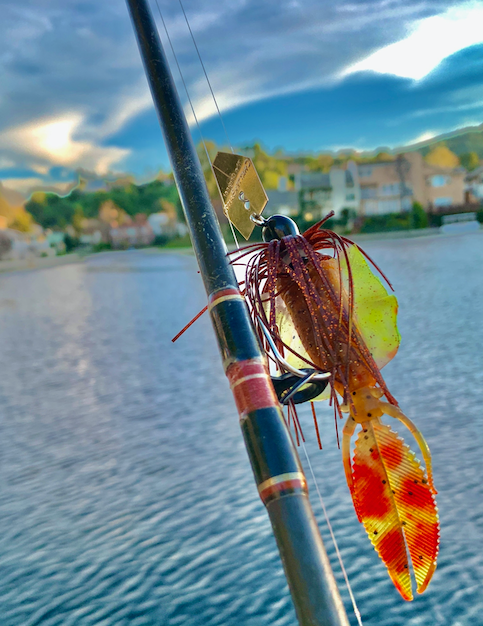
on this one bait to do it all. You can fish rocky bottoms, mid-water column, over the top of grass, next to weed lines, or throw it at lay-downs, pockets and ambush points along the shoreline. Theoretically, you could use one rod with one lure for the whole day.
- Don’t go naked
What you won’t often see used, is a naked ChatterBait, meaning one without a trailer attached. The bait was designed to carry a soft plastic bait threaded onto the hook behind the skirt and the variety of trailers available can be overwhelming. Basically, there are two different categories of trailers, baitfish or crawfish imitators. How do you know which one to use? Match the hatch. If you’re fishing deeper water, especially near rocks, or you catch a bass that spits up a crawdad, a crawfish trailer makes sense. If you meter or see baitfish, then go with a swimbait style trailer. The bigger the baitfish around, the bigger the trailer.
- Size and color matter
You can pretty much cover every situation with just a few weights and colors.
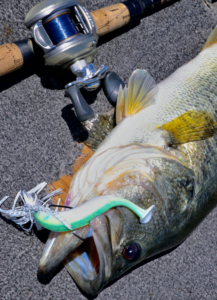
For shallow water, six feet or less, a three-eighths ounce ChatterBait is appropriate. For deeper water or heavier current, half-ounce to one-ounce gets the nod. As far as colors, the choices are endless but if I had to narrow it down to four colors, I’d suggest white, black/blue, orange/red and watermelon/green pumpkin. Use darker colors in darker water and lighter colors in clearer water, but match the prevalent bait. There are also options on blade color. You don’t need much flash in clear water, but brightly painted, unpainted or gold blades sometimes work better in stained water. Remember too, that crawdads start moving around more in early spring, so matching their color, be it greenish or red/orange, can reward you with a big-bellied bass.
- Modifying your ChatterBait and trailer
Most bass anglers keep their trailers matching or blending with the color of their ChatterBait, though there are modifications that can enhance their productivity. First off, make sure the trailer is the right length. If it’s too long, the bass may grab the tail and miss the hook. Some employ a stinger or trailer hook that attaches to the ChatterBait hook to avoid the short strikes. I’ve found these too often change the action of the trailer. Another option is to cut the front end of the trailer to shorten it. Even more important is to make sure the trailer is threaded on straight or it will affect its action.
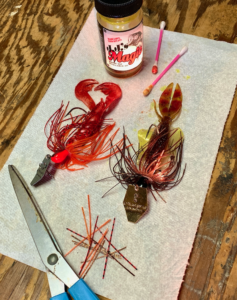
Similarly, check to see if the skirt length interferes with the action of the trailer. If so, cut a little off the end of it. To make your bait appear bulkier and slow its descent, try cutting a few strands of the skirt shorter than the rest to make some of them flair out. And if you’re fishing in murky water, you might dip the end of your trailer in a chartreuse or red fluorescent dye with something like JJ’s Magic, which also has a garlic scent to it. If you’re a tackle tinkerer like me, you can even take a Q-tip and dip it into the dye and create a pattern or paint an edge of contrasting color to your trailer.
Some swimbaits with paddle tails, like the Keitech, swim better upside down or with the boot end trimmed to thin it down, or even eliminated, to catch the displaced water from the blade better. Sometimes small modifications can be difference-makers.
- The retrieve – what to do and not do
One of the most versatile features of the ChatterBait has to do with the retrieve. Most common is the chuck-and-wind steady retrieve but it doesn’t always work. Many anglers give up on the ChatterBait too soon because that’s the only retrieve they use. Big mistake. A better choice is to vary the speed and cadence of your retrieve until you find what the bass want.
If you’re fishing the bottom, a slow-roll steady wind can work well, especially if your bait is bouncing off any rock or wood. A yo-yo retrieve (different than yo-yoing a jig in saltwater) is simply raising your rod tip up slowly from the 9 o’clock to 11 o’clock position, letting it fall and then reel to move the bait and repeat. Most often, they’ll eat it on the sink. Just make sure the blade keeps vibrating on the lift. A sideways drag-and-drop with an occasional pause is a similar way to impart more action to your retrieve. Even with a straight retrieve, suddenly accelerating your retrieve for a couple cranks, then going back to a slower cadence, will draw bites. You can even burn the ChatterBait or use it like a top water lure. The point here is to experiment with the speed and cadence of your retrieve to find out what they want.
The cover that you’re fishing plays a part in your retrieve as well. ChatterBaits excel when pulled over the tops of grass beds. You want to maintain a speed that keeps you in contact with the top of the grass. When you feel the grass grab your bait, speed up your retrieve a little to gently pop it lose which often triggers a strike, but not so much that you rip the bait away from the bass. You’ll know when you snag the grass or other debris because the bait will stop vibrating.
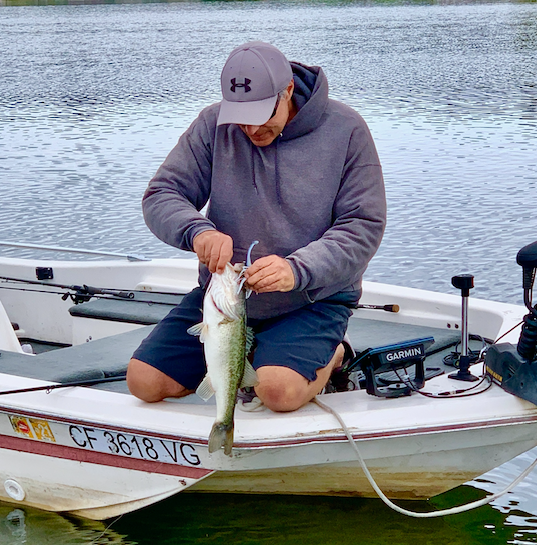
Fishing wood is another issue. Bass pro Gene Jenson, the Flukemaster, joked that when he wanted to cast to a wood covered pocket, he’d move his boat right up to it, cut his line and wave goodbye to his ChatterBait – because it was going to end up in the wood anyway. He learned the hard way that to prevent snags on wood don’t use swimbait trailers because they tend to roll over due to their body shape and get snagged. Instead, try using a flat-bodied craw trailer. The flat profile is less likely to roll over and snag the wood.
- How to set the hook
Sometimes a bass will absolutely crush your ChatterBait. But more often, you’ll just feel a slight variation in the way the bait is moving through the water. Either the bass is following the bait and interrupted the water flow around the bait, or is bumping the trailer. Get ready. You’re about to get bit. It takes focus and experience to feel those subtle changes in the way your bait is moving but that’s one of the keys to successful ChatterBaiting.
When you feel the bite, or the rod loads up, set the hook with a quick pull to the side and accelerated retrieve. Don’t swing-for-the-fences. If the bass jumps and spits the bait, the hook never penetrated. Been there, done that. Either you have too soft a rod and couldn’t drive the hook into it, or the bass just clamped down and never got the hook. Most ChatterBait anglers fish a medium/heavy, 7- to 7-foot 3-inch composite or glass rod, about a 7.1:1 gear ratio baitcaster filled with 40- to 65-pound braided line and a 15- to 20-pound fluorocarbon leader for maximum feel and minimum stretch. If your tackle wasn’t what caused the hook to pop out on the jump and that happens repeatedly, try changing your hook set style – give your rod two or three little pops as you’re pulling the rod to the side. This tends to dig the hook past the barb and keep you connected to the fish.
Next time you’re fishing for pre-spawn bass and can’t figure out what to throw, try a ChatterBait. It just might hook you that bass that your dentist hates, but you love. The one that gets your teeth chattering.



